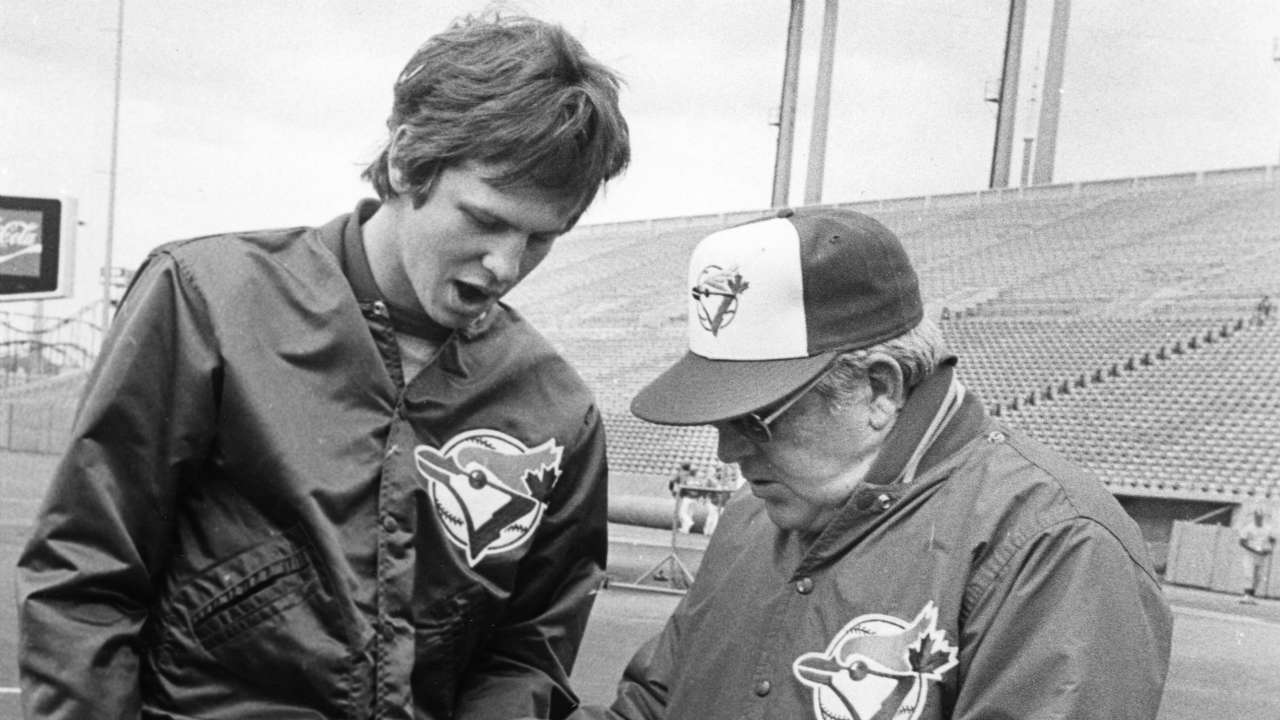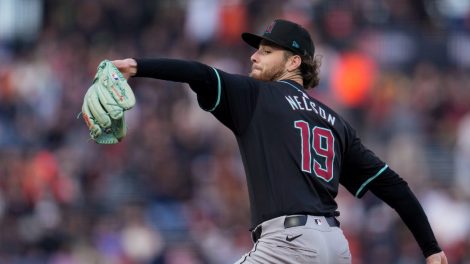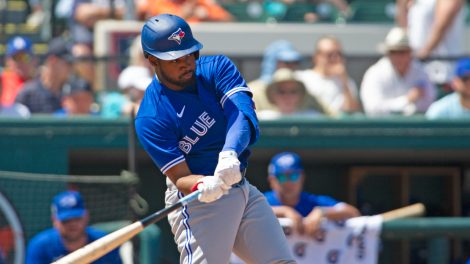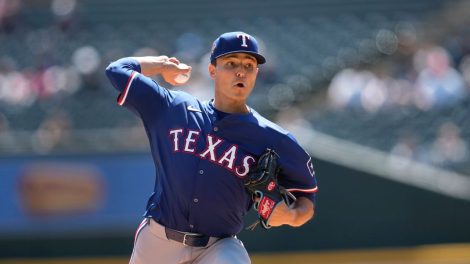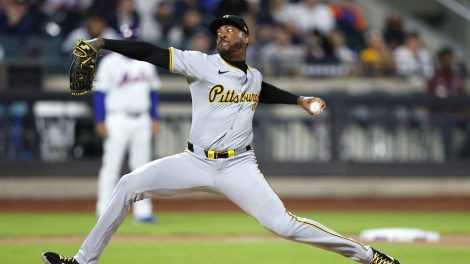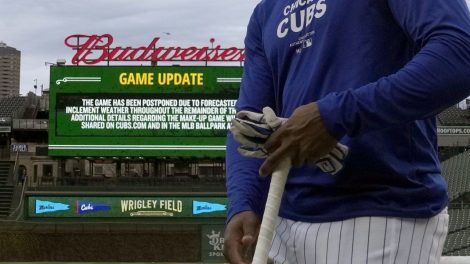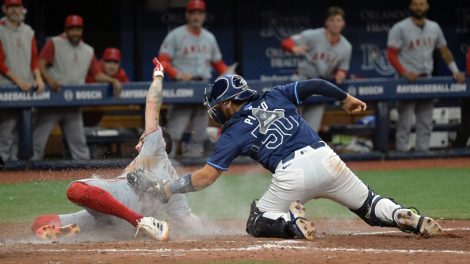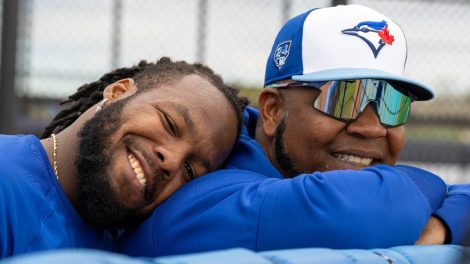When Vladimir Guerrero Jr. connected on a Nick Vincent fastball last Tuesday at Oracle Park, it travelled 438 feet to straight away centre field before finally landing for the first of what is expected to be many home runs hit by the Toronto Blue Jays’ rookie phenom.
In hitting this first homer, Guerrero Jr., became the youngest player to go deep in Blue Jays history at 20 years and 59 days old, just 18 days younger than the previous record holder, Danny Ainge.
Though best known for his career in basketball – most notably with the Boston Celtics both as a player and executive – Ainge was a remarkable athlete, excelling in high school in not just hoops, but football and even baseball.
In fact, Ainge was such a highly regarded baseball player that he managed to make it to the major-leagues, playing 211 big-league games across three seasons. An unlikely MLB career that started on this exact day (May 21) 40 years ago.
[snippet id=4545751]
Ainge’s pro baseball journey began when the expansion Blue Jays took him with the 389th pick in the 15th round of the 1977 MLB amateur draft out of North Eugene High School in Eugene, Ore.
This was a risky proposition by Toronto as they drafted Ainge right before he began what would be a prolific college career at Brigham Young University, but seeing as Toronto was devoid of top-tier talent as one of the newest organizations in the league at the time, the Blue Jays had no choice but to roll the dice.
“That was the first year we were in business. We only had 40 players in the whole organization,” then-general manager Pat Gillick told Sportsnet of his decision to draft Ainge. “So, consequently, we had to take some chances and try to get athletes we thought could play in the big leagues.
“So that was our first draft, our first season of operation. And I think you have to think outside the box.”
Gillick believed taking a flyer on an athlete of Ainge’s calibre would ultimately be worth it for the Blue Jays. And as Ainge began his pro baseball career, the diamond in the rough that Gillick and his scouting department saw before drafting him started to become more apparent.
“I know at one point in time, the late Bobby Mattick gave him the title of ‘the next Mike Schmidt,’ which is pretty big shoes to fill,” said Ainge’s former Blue Jays teammate Ernie Whitt. “I didn’t see that but I would never doubt what Bobby said. He was a tremendous [evaluator] of talent and he felt that strongly about Danny.” [sidebar]
Ainge was such a talent he immediately began his pro career at triple-A in 1978 and got called up to the Show the year after where he made his major-league debut with a strong performance, going 3-for-4 with three runs scored and an RBI.
He bounced a lot between the Blue Jays and triple-A Syracuse over his career, all while also playing college basketball at BYU, where his true focus was becoming evident.
“He was such a great guy, he was such a great listener and he tried to learn the game but he was coming from basketball,” said Lloyd Moseby, another former Blue Jays teammate who also revealed that Ainge’s nickname back then on the team was ‘Pup.’
“He just didn’t play enough,” Moseby added. “I played winter ball, season, winter ball, season. He played Major League Baseball. That’s it. But it kind of tells you what kind of talent he had to do that.”
Ultimately, the pull of the hardwood was just too magnetic for Ainge, as he also played pick-up hoops semi-regularly in secret with Moseby even during his baseball season in the summer.
“My contract said, ‘No basketball,’ so we played pick-up with nobody else – I think Barfield might’ve played, but we didn’t want any more Blue Jays because it might leak,” said Moseby. “It was a blast playing with Danny, he was a stud.”
[snippet id=3305549]
But even though Moseby could see it playing with and against Ainge in those covert runs, it took a while for NBA clubs to realize just what kind of talent he actually was.
“He was not well thought of by the NBA until his senior year in college,” said Gillick. “I knew the scouting director for the NBA and the NBA guys said that he was too slow for the NBA – had a very slow first step. So he didn’t think that he was gonna be drafted very high.
“That was from his freshman year through his junior year, but in his senior year he kind of put it all together and that’s when he had more success in the NCAA playing basketball at BYU.”
Gillick is underselling the season Ainge had in his final year in college. In the 1980-81 season, he averaged 24.4 points on 51.8 per cent shooting as a guard. This earned him the WAC Player of the Year, a consensus first-team All-American selection and the John R. Wooden Award as the nation’s most outstanding player.
And, perhaps most importantly, that season also made him a nationally recognized name after he sunk one of the most famous baskets in NCAA Tournament history, going coast-to-coast against Notre Dame to give BYU a 51-50 victory.
After seeing the kind of collegiate season he had and the national headlines he drew with the late-game heroics, Ainge could no longer be ignored by the NBA and was taken with the 31st-overall pick in the second round of the 1981 NBA Draft by the Celtics.
A move that Boston, technically, wasn’t allowed to make.
“The NBA was put on notice that [Ainge] was under contract to Toronto and that if they drafted him there was basically what they call ‘Tortious Interference,’ which would be interference with a contract that was enforced, which we had a contract enforced,” Gillick explained. “The Celtics just decided to do that so we had no other course but to take them to federal court.”
As dramatic as a federal trial sounds, things between the Blue Jays and Celtics appeared to reach an amicable end with both teams coming to terms on an agreement with each other with details of this agreement being “confidential,” says Gillick.
In the end, things worked out pretty well for Ainge as he went on to win two NBA championships with the Celtics, was named an NBA all-star in 1988 and even managed to win another ring with Boston in 2008 as a GM, a position he still holds to this day.
These are the bullet points that Ainge will best be remembered by, but for at least on this day it’s OK to remember where he first got his start as a pro athlete: A member of the Blue Jays.
And who knows? Maybe if Ainge had actually stuck with baseball he could’ve been a player every bit as good as Guerrero Jr., is expected to be.
“I think he would’ve been an all-star,” said Gillick.
[relatedlinks]

